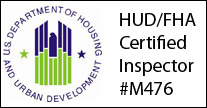MOISTURE DAMAGED HOUSE SIDING MATERIALS – Fiberous or wood type sidings will eventually become moisture damaged and need to be replaced if not properly maintained through periodic painting.
MOISTURE DAMAGED WOOD DOOR FRAMING – Bottom of door frames and jamb plates are often found to be moisture damaged. These areas should be frequently maintained with paint and proper caulking.
MOISTURE DAMAGED WOOD WINDOWS AND WINDOW FRAMING – Wood window frames and sill plates will become moisture damaged when not properly maintained with paint and proper caulking.
INADEQUATE AND DETERIORATED CAULKING – It is very common to see cracked and deteriorated caulking around exterior windows, doors, hose bibs, dryer vents, air-conditioner lines and any other item that penetrates the house siding from the exterior to the interior. Inadequate and deteriorated caulking is also seen in the bathroom around the commode, tub, shower, and sink areas. Over time this problem will only lead to moisture damage.
DETERIORATED ROOF FLASHINGS – Roof flashings are materials placed around roof penetrations such as heater flues, chimneys, plumbing vents, ventilation wind turbines, and exhaust vents that prevent water from entering the inside around them. They can become loose, cracked and deteriorated and should be repaired.
WINDOWS THAT WILL NOT OPEN – There should be at least one window in every room in the house that will open. Many times windows have been painted shut and will not open. This is a potentially hazardous safety problem that should always be corrected.
FAULTY ELECTRICAL WIRING PROBLEMS – Wiring problems such as, wires hanging out of the garbage disposal under the sink, wiring problems inside the main electrical panels and sub-panels, faulty or missing GFCI (ground-fault-interrupter) type outlets, and old outdated and ungrounded electrical wiring are all problems that need to be corrected.
SMOKE ALARMS THAT DO NOT WORK – Smoke alarms should be tested on a periodic basis and replaced if not working properly.
CRACKED FIREPLACE FIREBOXES – The firebox is where wood or a gas burner is placed. A crack could allow sparks to get behind the firebox and possibly start a serious house fire. A cracked firebox needs to be repaired or replaced.
CHIMNEY FLUE CREOSOTE BUILD-UP – A dirty fire place, where creosote has build up sufficiently along the flue walls could start a serious fire within the flue and needs to be properly cleaned by a professional.
WATER LEAKS UNDERNEATH COMMODES AND TUBS – Worn or faulty fixtures, plumbing, and caulking can lead to slow leaks, which over time can cause major floor structure problems.
EXHAUST VENTS THAT DO NOT TERMINATE TO THE OUTSIDE – All exhaust fans should terminate to the outside and not within the attic, which can lead to moisture damage to plywood and wood members over time.









